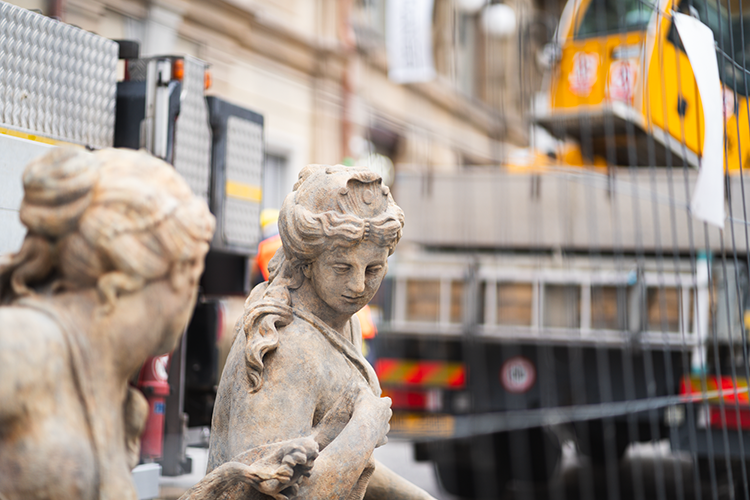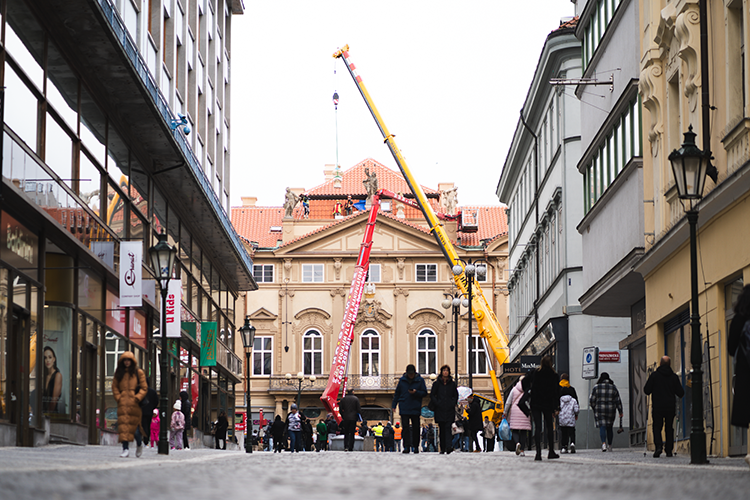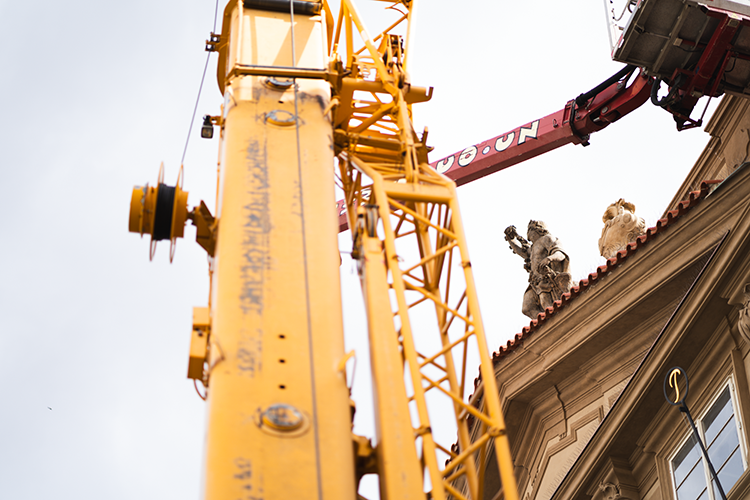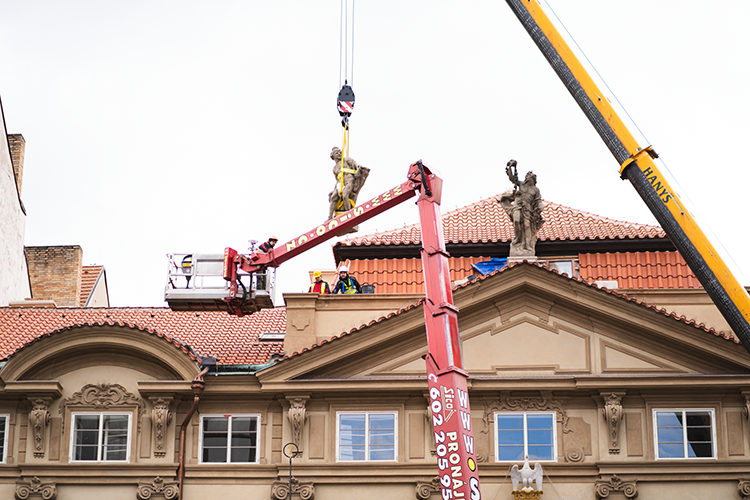Statues have returned to the facade of the reconstructed baroque Savarin Palace, Prague
The painstaking reconstruction and restoration of the historic Savarin Palace in the centre of Prague is coming to a close. Last week, newly created and restored older copies of eleven original Baroque statues were placed on top of the façade facing Na Příkopě Street. The originals, created in 1752 by the renowned sculptor Ignác František Platzer, were also restored. The reconstruction of the historic building is expected to be fully completed in the summer, with tenants gradually moving into the space. The reconstruction of the Savarin Palace is the first phase of a project of the same name that will open up the previously closed courtyard to the public, including a park and a new metro entrance.
"The reconstruction of the Baroque palace by Kilian Ignaz Dientzenhofer is the first swallow of the entire Savarin project, and due to its great historical value we have worked very closely with the conservationists here. We had copies of the original Baroque sculptures created for the façade, which we carefully restored at a cost of several million crowns. We are now working out where to place the originals so that the public can see them in all their glory," says Simon Johnson, director of Crestyl, the developer of the Savarin project.
The statues adorning the Savarin Palace were created in 1752 by Ignác František Platzer, who is the main representative of Czech sculpture in the second half of the 18th century. He is the author of a number of sculptures, for example, at Prague Castle, the Kinsky Palace, the Archbishop's Palace, St. Nicholas Church in Prague, the Teplá Monastery, as well as in the park of Schönbrunn Palace in Vienna. For the exterior decoration of the palace Savarin made a total of eleven sculptures - Satyr, Nymph, Swan and decorative vases. These sculptures reach a size of up to two metres and are among the most valuable originals of Czech Baroque art. The statues were dismantled from the Savarin Palace in a completely dilapidated state six years ago. Seven of them were originals, the other four were copies made in 1878.
"Restoring the original sculptures and creating new ones was a challenge for us, but we love unconventional and complex work. Seven sculptors worked on the copies of the statues and it was a challenging job in terms of time and choice of material to ensure it was of good quality and would last for hundreds of years to come. Each piece took anywhere from seven months to complete for the vases to ten months for the copies of the statues. The Satyr in particular was demanding - to give you an idea, the block of stone we used to create it was three metres high, almost a metre wide and deep, and weighed seven tonnes. In total, the copies of the statues used approximately fifteen cubic metres of stone weighing around forty tonnes," says Bohumil Pánek, the stone sculptor who supervised the work on the statues.
The reconstruction and restoration of the historic baroque Savarin Palace by Kilian Ignaz Dientzenhofer has been underway since the end of 2021 and will be completed in the summer. During the renovation work, a number of valuable details were uncovered, the repair of which has been intensively discussed with the conservationists on an ongoing basis. Crestyl has invested approximately half a billion crowns in the meticulous reconstruction of the palace, which is sometimes referred to as the Sylva-Taroucca Palace.
In conjunction with the restoration of the Savarin Palace, a new part of the project of the same name is being developed under the baton of contemporary global architecture and design icon Thomas Heatherwick. It has already received a positive opinion from the conservation authorities as part of the ongoing planning procedure. With reference to the tradition of the Wenceslas arcades, the Savarin project will connect Wenceslas Square with Na Příkopě, Jindřiška and Panská streets. It will consist of four interconnected, yet mutually interlinked separate parts, each with its own character and use. This honours the traditional Prague urban layout, where different sized streets, squares, courtyards or parks are linked together to form a harmonious whole. The project respects the long-term development of the site, the structure and the combination of functions that have always belonged to Wenceslas Square.
"The aim of the entire Savarin project is to preserve and reconstruct all the hitherto neglected historic buildings in the very heart of the metropolis and to make them as accessible as possible. We will bring life back to the inner blocks by restoring the garden and creating a little square, and we will connect the preserved courtyards with completely new passages. But as part of the project, we will also open up the historic riding hall, which almost nobody knows about because it is not visible from the surrounding streets," adds Simon Johnson.
At the centre of the project is the historic riding hall, around which a new quiet square with a garden, cafés and restaurants will be created in the courtyard, and Savarin will also include a multi-purpose space designed especially for cultural and social events or a new entrance to the metro. The project also envisages a gallery to house the Slavonic Epic.
The studio behind the Savarin is Thomas Heatherwick, one of the most successful architectural and design studios in the world today and the author of unique projects all over the world, and often awarded for revitalising abandoned spaces. For example, Heatherwick's transformation of an old silo in Cape Town into the Zeitz MOCAA Museum of Contemporary African Art has been awarded the title of Global Building of the Year, while projects such as New York's Vessel and London's Coal Drops Yard, among many others, have also won awards.
Permitting processes are now running as standard for the newly developed Savarin section of the project, with the project in the planning process. The completion date is then expected to be within three years of the start of actual construction, with the exact timing dependent on the issue of all necessary permits. The first phase of the project, represented by the reconstruction of the Savarin Palace itself, is expected to be completed this summer.












